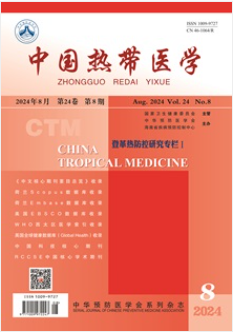From elimination to post-elimination: Characteristics, challenges and re-transmission preventing strategy of imported malaria in China
引用次数: 9
Abstract
Objective To analyze malaria epidemiological characteristics in China, 2010-2019, so as to provide evidence-based proof for target interventions on malaria elimination. Methods The data of web-based Infectious Disease Information Reporting Management System (IDIRMS) and Parasitic Diseases Information Reporting Management System (PDIRMS) from 2010 to 2019 were collected and analyzed. Results During 2010-2019, imported malaria cases were reported in all provinces, and in total 29 248 reported cases(2 925 cases annually), including 767 clinically diagnosed cases (2.62%), 7 388 Plasmodium vivax cases (25.26%), 18 032 P. falciparum cases (61.65%), 524 P. malariae cases (1.79%), 2 049 P. ovale cases (7.01%), 370 mixed-infection (1.27%), 2 P. knowlesi (0.01%), and 116 unclassified cases (0.40%). The imported malaria cases were mainly from Myanmar (2 750 cases, 9.40%), Ghana (2 606, 8.91%) and Nigeria (2 127, 7.27%); and most of them were reported in Yunnan (5 794, 19.81%), Guangxi (3 130, 10.70%) and Jiangsu (2 917, 9.97%). The temporal distribution was concentrated in June (4 141, 14.16%). Most cases (27 454, 93.87%) were found in male. A total of 181 deaths resulting from P. falciparum were reported. No obvious difference was found among interval from onset to diagnosis during the same timeframe ( P >0.05). From 2013 to 2019, the imported cases were mainly diagnosed (8 680, 39.75%) and reported (8 783, 40.22%) at county level. The proportion of diagnosis and report at county level exhibit an decreasing trend, while the municipal level was seen with a increasing trend. From 2013 to 2019, the imported cases were diagnosed (15 730, 72.03%) and reported (16 536, 75.72%) by medical institutions. The proportion of diagnosis and report by medical institutions exhibit an increasing trend, while the CDC institutions were observed with a decreasing trend. Conclusion To prevent the re-establishment caused by imported malaria, it is necessary to continue to strengthen inter-sectoral collaboration and surveillance, to carry out timely detection and appropriately treatment of imported cases, carefully investigate and assess the transmission risk of imported cases, and timely response to the risk foci or population. Furthermore, it is essential to conduct “strengthen inter-sectoral collaboration, timely case detection, promptly foci response” to effectively blocking the risk of re-establishment, and consolidating the achievements of malaria elimination. 摘要:目的 分析 2010—2019 年全国输人性疟疾疫情特征, 为各地消除疟疾后防止输人再传播工作提供依据。 方法 利用中国疾病预防控制中心疾病监测信息报告管理系统 (网络直报系统) 和寄生虫病监测信息报告管理系统 (寄生虫病专报系统), 收集 2010—2019 年全国输人性疟疾疫情数据资料, 建立数据库进行统计分析。 结果 2010—2019 年, 全国各省均有输人性疟疾病例分布, 共报告 29 248 例(年均 2 925 例), 其中临床诊断疟疾病例 767 例 (2.62%)、 间日疟 7 388 例 (25.26%)、恶性疟 18 032 例 (61.65%)、三日疟 524 例 (1.79%)、卵形疟 2 049 例 (7.01%)、诺氏疟 2 例 (0.01%)、混合感染 370 例 (1.27%) 和未分型病例 116 例 (0.40%)。病例主要输自缅甸 (2 750 例, 9.40%)、加纳 (2 606 例, 8.91%) 和尼日利亚 (2 127 例, 7.27%) 等国;主要分布在云南 (5 794 例, 19.81%)、广西 (3 130 例, 10.70%)和江苏 (2 917 例, 9.97%)等省份。病例主要在 6 月 (4 141 例, 14.16%) 报告。人群分布中以男性为主 (27 454 例, 93.87%)。死亡病例 181 例, 均为恶性疟。2010—2019 年病例发病到诊断时间间隔各年差异无统计学意义 ( P >0.05)。病例主要在县级机构 诊断 (8 680 例, 39.75%) 和报告 (8 783 例, 40.22%), 但呈逐年下降趋势, 地市级机构呈现明显上升趋势;主要在临床医疗 机构诊断 (15 730 例, 72.03%) 和报告 (16 536 例, 75.72%), 且逐年上升, 疾控机构比例在逐年下降。 结论 针对消除后 输人性疟疾的重大威胁, 应进一步加强部门间联防联控, 强化监测, 及时发现和规范治疗输人病例, 开展传播风险调査 和评估, 对风险疫点和重点人群进行及时响应和处置, 通过以“强化联防、及时发现、快速处置”为核心的综合性策略和 措施防止疟疾输人再传播, 巩固消除疟疾成果。从消除到后消除:中国输入性疟疾的特点、挑战及再传播预防策略
目的分析2010-2019年中国疟疾流行病学特征,为有针对性的消除疟疾干预措施提供循证依据。方法收集2010 - 2019年基于网络的传染病信息报告管理系统(IDIRMS)和寄生虫病信息报告管理系统(PDIRMS)的数据并进行分析。结果2010-2019年,全省共报告输入性疟疾病例29 248例(年报告2 925例),其中临床诊断病例767例(2.62%),间日疟原虫7 388例(25.26%),恶性疟原虫18 032例(61.65%),疟疾疟原虫524例(1.79%),卵状疟原虫2 049例(7.01%),混合感染370例(1.27%),诺氏疟原虫2例(0.01%),未分类感染116例(0.40%)。输入性疟疾病例主要来自缅甸(2750例,占9.40%)、加纳(2606例,占8.91%)和尼日利亚(2127例,占7.27%);以云南(5 794例,占19.81%)、广西(3 130例,占10.70%)和江苏(2 917例,占9.97%)为主。时间分布集中在6月(4 141,14.16%)。男性27 454例,占93.87%;据报告,共有181人死于恶性疟原虫。同一时间段内发病至确诊间期无明显差异(P >0.05)。2013 - 2019年,输入性病例以县级确诊病例8 680例(39.75%)和报告病例8 783例(40.22%)为主。县级诊断报告比例呈下降趋势,市级诊断报告比例呈上升趋势。2013 - 2019年,医疗机构确诊输入病例15 730例(72.03%),报告输入病例16 536例(75.72%)。医疗机构诊断率和报告率呈上升趋势,疾病预防控制机构诊断率和报告率呈下降趋势。结论为防止输入性疟疾再次发生,应继续加强部门间合作和监测,及时发现并妥善处理输入性病例,认真调查和评估输入性病例的传播风险,及时应对风险源或人群。此外,必须“加强部门间合作,及时发现病例,迅速对焦点作出反应”,以有效阻止重新建立的风险,巩固消除疟疾的成就。摘要:目的 分析 2010—2019 年全国输人性疟疾疫情特征, 为各地消除疟疾后防止输人再传播工作提供依据。 方法 利用中国疾病预防控制中心疾病监测信息报告管理系统 (网络直报系统) 和寄生虫病监测信息报告管理系统 (寄生虫病专报系统), 收集 2010—2019 年全国输人性疟疾疫情数据资料, 建立数据库进行统计分析。 结果2010 - 2019年,全国各省均有输人性疟疾病例分布,共报告248年29例(年均2 925例),其中临床诊断疟疾病例767例(2.62%),间日疟388年7例(25.26%),恶性疟032年18例(61.65%),三日疟524例(1.79%),卵形疟049例(7.01%),诺氏疟2例(0.01%),混合感染370例(1.27%)和未分型病例116例(0.40%)。病例主要输自缅甸(2 750例,9.40%),加纳(606例,8.91%)和尼日利亚(2 127例,7.27%)等国;主要分布在云南(5 794例,19.81%)、广西(130例,10.70%)和江苏(917例,9.97%)等省份。6个月(4141个月,14.16%)(27 454, 93.87%)。死亡病例 181 例, 均为恶性疟。(p >0.05)。病例主要在县级机构诊断(8 680例,39.75%)和报告(8 783例,40.22%),但呈逐年下降趋势,地市级机构呈现明显上升趋势,主要在临床医疗机构诊断(15 730例,72.03%)和报告(536例,75.72%),且逐年上升,疾控机构比例在逐年下降。结论 针对消除后 输人性疟疾的重大威胁, 应进一步加强部门间联防联控, 强化监测, 及时发现和规范治疗输人病例, 开展传播风险调査 和评估, 对风险疫点和重点人群进行及时响应和处置, 通过以“强化联防、及时发现、快速处置”为核心的综合性策略和 措施防止疟疾输人再传播, 巩固消除疟疾成果。
本文章由计算机程序翻译,如有差异,请以英文原文为准。
求助全文
约1分钟内获得全文
求助全文
来源期刊
CiteScore
0.60
自引率
0.00%
发文量
13927
期刊介绍:
China Tropical Medicine, was approved by the Ministry of Science and Technology in 2001, is the only tropical medicine periodical under the charge of the National Health Commission of China. It’s organized by Hainan Provincial Center for Disease Prevention and Control, and Chinese Preventive Medicine Association.
The journal is indexed by the following database: Scopus database, Embase database, EBSCO Database, The Western Pacific Region index medicus (WPRIM), American Chemical Abstracts (CA), International Centre for Agricultural and Biological Sciences Research Database (CABI), Global Health Database, Database of the Ulrich's Periodicals Directory, China Science and Technology Core Journals, China Core Journals (Selection) Database, Database of Chinese Biomedical Literature, Comprehensive Evaluation Database of Chinese Academic Journals, CAJCD Code of Conduct Excellent Journal, Database of Chinese SCI-Tech Periodicals, China Journal Full Text Database.

 求助内容:
求助内容: 应助结果提醒方式:
应助结果提醒方式:


